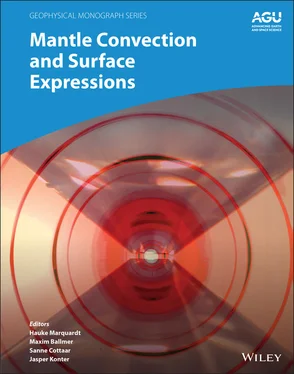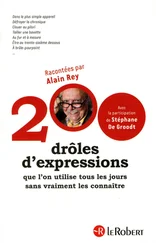In the top of the lower mantle, single crystal elastic properties of ferropericlase are nearly isotropic (Marquardt et al., 2009). Furthermore, experiments seem to indicate that in the presence of Brg, Fp will not develop significant texture (Kaercher et al., 2016; Miyagi & Wenk, 2016; Wenk, Lonardelli, et al., 2006), and thus ferropericlase is unlikely to be a source of anisotropy in the top of the lower mantle. Ca‐Pv can have large single crystal elastic anisotropy at the top of the lower mantle (Karki & Crain, 1998), but its contribution to anisotropy has not been explored. Recent shear experiments on Brg show texture and anisotropy development that is qualitatively consistent with observations of seismic anisotropy in the top of the lower mantle(Tsujino et al., 2016). Thus, Brg with slip on (100)[001] appears to be the most likely candidate to explain anisotropy in this region.
In the lowermost mantle simulations of D” anisotropy do not provide a clear consensus on which phases and slip systems provide the best match. Studies by Chandler et al. (2018), Cottaar et al. (2014), and Wenk et al. (2011) find that pPv with slip on (001) planes provides the best match to anisotropy in the circum‐pacific region. In contrast, Nowacki et al. (2013) and Walker et al. (2011) found that pPv with slip on (010) provides the best match to global observations. Interestingly these result are most strongly correlated in regions of Large Low Shear Velocity Provinces (LLSVPs), where it is unclear if pPv is stable (e.g., Grocholski et al., 2012). Ford and Long (2015) tested the predictions of Walker et al. (2011) against their measurements of shear wave splitting at the eastern edge of the African LLSVP and found a large misfit between the model and observations. However, if constraints on the direction of the flow field were relaxed, pPv with slip on (010) provided the best match. Most recently, models including the effects of the the Brg to pPv phase transition on texture development have been performed using flow models from convection simulations (Chandler et al., 2018) and from instantaneous flow field models (Walker et al., 2018). Both of these studies find the best fit to global anisotropy with pPv deformed by dominant slip on (001) planes. A recent study on Fp at high pressure and temperatures found that slip on {100}〈011〉 could explain complex and laterally varying anisotropy near the edges of LLSVPs (Immoor et al., 2018).
In the mantle, polyphase interactions could play an important role in texture development however; to date most models of anisotropy are based on single phase experimental results. Additionally, most simulate deformation of single phases rather than deformation of a polyphase aggregate. The exceptions are the simulations of Cottaar et al. (2014), which contain Brg/pPv 75% and Fp 25%, Chandler et al. (2018), which uses an aggregate of Brg/pPv 60%, Fp 20%, and CaPv 20%, and Tommasi et al. (2018), which uses an aggregate of pPv 70% and Fp 25%. However, all of these studies use VPSC to simulate texture development. As a homogenization scheme (as opposed to full field methods), VPSC does not account for microstructural effects other than phase proportion, grain shape evolution, and grain orientation. Thus, VPSC cannot track spatial relationships between grains and phases and cannot distinguish between IWL or LBF microstructures and also cannot account for local variations in the stress–strain field. If Fp in the lower mantle does not develop texture when deformed with bridgmanite then any ansiotropy observed in the bulk of the lower mantle is likely due to bridgmanite. This would also imply that the observation of isotropy in the bulk of the lower mantle is likely due to a lack of texture devlopment in all the phases, e.g., due to diffusion creep (Karato et al., 1995) and/or pure climb creep (Boioli et al., 2017; Cordier & Goryaeva, 2018; Reali et al., 2019), rather than texturing where anisotropy patterns of the individual phases cancel each other (Wenk, Speziale, et al., 2006). It remains to be seen how texture develops in aggregates of pPv + Fp of Brg+pPv+Fp, but this will have important consequences for sources of anisotropy in the lowermost mantle.
Although considerable progress has been made toward rheology studies of lower mantle phases, high pressure and temperature deformation studies particularly at steady state deformation conditions remain sparse. Significant advances have been made in documenting texture development and slip system activities in lower mantle phases and some general trends are observed with respect to differential stress measurements in these phases. Based on the experimental body as a whole, at mantle pressure Fp appears to be significantly weaker that Brg; however, the strength contrast as a function of pressure, temperature, and strain remains poorly constrained. As would be expected the strength of both of these phases decreases with increased temperature and with decreased strain rates. Room‐temperature strengths of Brg and MgSiO 3pPv seem to indicate that MgSiO 3pPv is weaker than Brg, but there is a large pressure gap between measurements in these two phases. Texture development in two‐phase aggregates also exhibits complex behavior with high plastic anisotropy hard phases disrupting texture development in softer more highly strained phases. Bulk behavior of lower mantle polyphase aggregates (i.e., rocks) remains relatively unstudied but has important implications for mechanical properties and anisotropy development in the deep Earth. Challenges exist both to interpretation of bulk rheology of these materials and texture development in the various phases. Systematic studies of polyphase deformation documenting the effects of strength contrast, plastic anisotropy, and microstructure will be vital moving forward. Additional complications may occur at high temperatures where possibilities exist for phases to deform by different deformation mechanisms. Recent technical advances in experimental deformation as well as theoretical developments have provided new capabilities to tackle these problems in the near future.
LM acknowledges support from the National Science Foundation through EAR‐1654687 and from the Capitol DOE Alliance Center (CDAC). LM would also like to thank two anonymous reviewers and editor H. Marquardt, whose comments greatly improved the manuscript.
1 Allègre, C. J., & Turcotte, D. L. (1986). Implications of a two‐component marble‐cake mantle. Nature, 323(6084), 123–127. https://doi.org/10.1038/323123a0
2 Ammann, M. W., Brodholt, J. P., Wookey, J., & Dobson, D. P. (2010). First‐principles constraints on diffusion in lower‐mantle minerals and a weak D′′ layer. Nature, 465(7297), 462–465. https://doi.org/10.1038/nature09052
3 Amodeo, J., Carrez, P., & Cordier, P. (2012). Modelling the effect of pressure on the critical shear stress of MgO single crystals. Philosophical Magazine, 92(12), 1523–1541. https://doi.org/10.1080/14786435.2011.652689
4 Amodeo, J., Dancette, S., & Delannay, L. (2016). Atomistically‐informed crystal plasticity in MgO polycrystals under pressure. International Journal of Plasticity, 82(March), 177–191. https://doi.org/10.1016/j.ijplas.2016.03.004
5 Amodeo, J., Merkel, S., Tromas, C., Carrez, P., Korte‐Kerzel, S., Cordier, P., et al. (2018). Dislocations and Plastic Deformation in MgO Crystals: A Review. Crystals, 8(6), 240. https://doi.org/10.3390/cryst8060240
6 Andrault, D., Muñoz, M., Bolfan‐Casanova, N., Guignot, N., Perrillat, J. P., Aquilanti, G., & Pascarelli, S. (2010). Experimental evidence for perovskite and post‐perovskite coexistence throughout the whole D′ region. Earth and Planetary Science Letters, 293(1–2), 90–96. https://doi.org/10.1016/j.epsl.2010.02.026
Читать дальше












